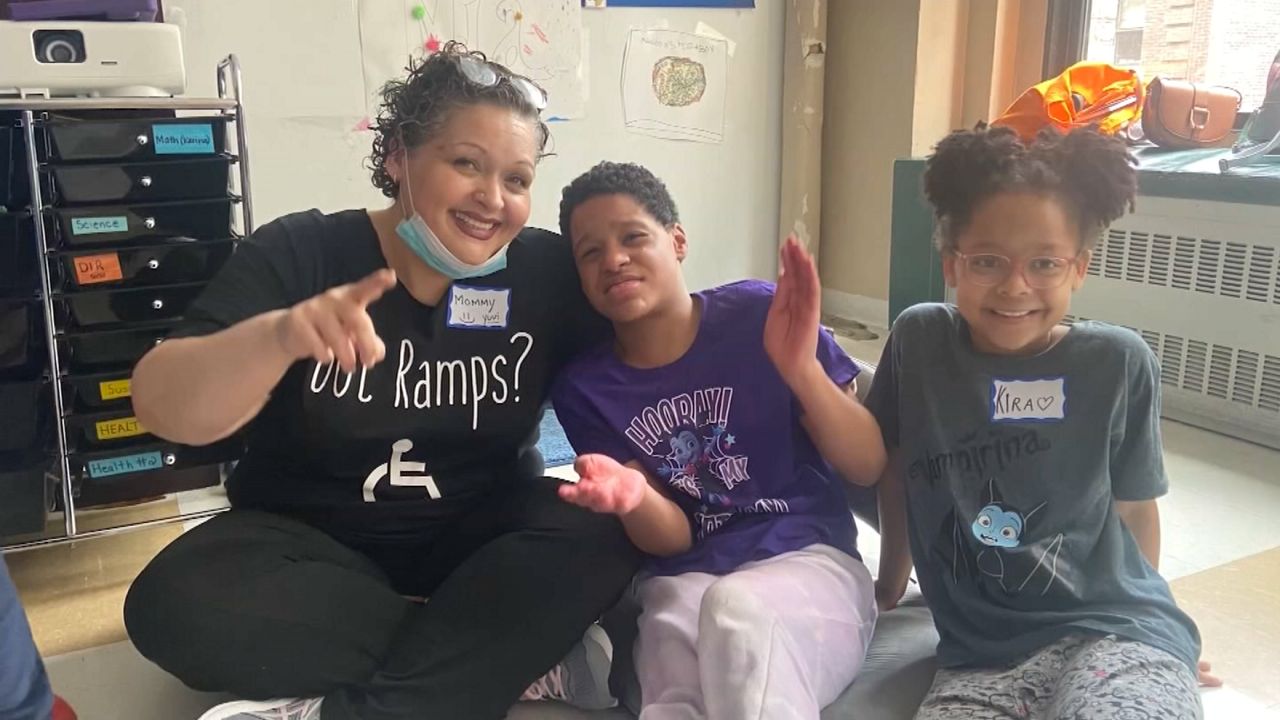Mia Simpson uses a wheelchair. She attended PS 138 in Harlem through the fourth grade when she noticed that all her friends were going upstairs, which she couldn’t do because the school didn’t have an elevator.
“The physiotherapist thought maybe she could practice going up and down the stairs as part of the session, but the safety device went off and we realized we couldn’t do that,” her mother, Yuvania Espino, said.
Her mother eventually decided to transfer her to a different school, and now Mia attends a private school paid for by the city, which meant she was unable to attend her fifth-grade graduation with the kids she’d known since kindergarten.
“It’s sad that a child should be excluded from a program that they may enjoy or love just because they have a disability,” Espino said. “It makes me sad for parents who can’t choose a school based on grades or what it has to offer. The last thing a parent should be thinking is, ‘Will my child be able to get into the school building?'”
What you need to know: Only 34 percent of school buildings are physically accessible to people with disabilities, according to a new report by advocacy groups for children.
That’s an improvement from the previous report in 2018, but it means that three decades after the Americans with Disabilities Act was enacted, two-thirds of city schools are still not fully accessible.
This means that children who use wheelchairs do not have the same school choice as their peers and may not be able to fully participate in school if schools are not sufficiently accessible.
Mia isn’t alone: A new report from a children’s advocacy group found that two-thirds of the city’s public schools are not fully accessible to people with disabilities.
There are more than 1,400 school buildings in the city, some housing multiple schools.
This year:
Of these school buildings, only 34% are fully accessible, 20% are partially accessible, nearly 5% are not fully accessible, 41% are not fully accessible but are in the process of being improved, and are completely or functionally inaccessible.
AFC uses the term “functionally inaccessible” for buildings that can be accessed by wheelchair users but do not have classrooms on the first floor, meaning they are not an educational option for those students.
Partially accessible schools have classrooms that children can access, but which may be cut off from the majority of the building.
“They may be able to come in through the door, but there may be areas of the building that are totally off-limits, which means they can’t go into science labs, they can’t take classes, they can’t join certain clubs — they’re not a full part of the school community,” Peart said.
The numbers are grim, but they’re an improvement from 2018, when AFC reported that just 19.5 percent of schools were fully accessible. Those numbers, along with a 2015 investigation by then-U.S. Attorney Preet Bharara, prompted the city to commit $750 million to capital projects to make improvements.
“The investments made five years ago have had a big impact,” said Sarah Peart, a senior policy analyst at Advocates for Children, “but we still have a lot of work to do, given where we started five years ago, where accessibility in the last capital plan was dismal.”
Child advocates are calling on the city to continue investing by spending $1.25 billion in the next five-year capital plan, about 5-6% of the capital plan, which funds large construction projects in the city over five years.
“This is just a small part of how far we still have to go. We’re not going to get anywhere close to 100 percent complete accessibility in the next five years,” Peart said.
She says the $1.25 billion request is realistic: “It’s very achievable and should enable full accessibility to about 50 percent of our core school facilities.”
A School Construction Authority spokesman pointed to the progress noted in the report and the $750 million plan.
“New York City Public Schools and SCA are working together to identify 65 accessibility projects to make one-third of the city’s buildings fully accessible and at least half of its elementary school buildings fully or partially accessible,” spokesman Kevin Ortiz said. “We look forward to working with advocates, parents and stakeholders in the upcoming 2025-2029 capital plan to further this effort to make more schools accessible.”
Inaccessibility doesn’t just affect students in a particular building, it can mean that teachers, parents and siblings also can’t access a particular school.
Even though she has moved to an accessible school, Mia still can’t attend events at her sister Kira’s school, such as a recent performance in the second-floor auditorium.
“It just feels so unfair because sometimes I think my daughter could really enjoy it and she would be sad if she couldn’t come,” Kira said.
It’s a problem families constantly face when their loved one is in a wheelchair.
“I want people to understand what it’s like for a family to have to make the decision to exclude a member of their family because they don’t have access,” Espino said, noting that even though Kira is only 8 years old, she already knows she has to include her sister in the places she visits.
“She wants her sister to be involved in every aspect of her life and I want everyone to keep in mind that the ramp and elevator system is taking that away from her,” Espino added.

